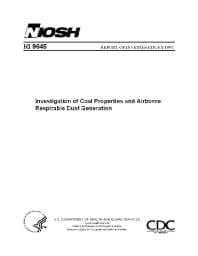Mining Publication: Investigation of Coal Properties and Airborne Respirable Dust Generation
Original creation date: October 1998
Authors: JA Organiscak, SJ Page
NIOSHTIC2 Number: 20000281
Pittsburgh, PA: U.S. Department of Health and Human Services, Public Health Service, Centers for Disease Control and Prevention, NIOSH, DHHS (NIOSH) Publication No. 98-160, Report of Investigations 9645, 1998 Oct; :1-16
Laboratory crushing experiments were conducted on a range of low- to high-volatile bituminous coals to investigate the various factors influencing airborne respirable dust (ARD) generation. This research was conducted to identify the principles of ARD liberation from the coal product. Five U.S. bituminous coals were uniformly prepared and processed through a double roll crusher located in a low-velocity wind tunnel. Experimental factors studied included inherent coal seam constituents, coal grindability, specific energy of crushing, product size characteristics, dust cloud electrostatic field, and specific ARD generated. The results of this investigation indicate that a combination of several factors are associated with ARD generation. One factor is the effect of coal rank, described by the inherent moist fuel ratio, on the product size characteristics, defined by Schuhmann size function parameters. Another key factor is the effect of air dry loss (ADL) moisture in the coal seam on the breakage-induced electrostatic field of airborne dust. The effect of these factors is that different percentages of <10-)m coal particles are dispersed as ARD. A discussion of electrostatic field principles, coal ADL, and its effect on ARD generation is presented.

NIOSHTIC2 Number: 20000281
Pittsburgh, PA: U.S. Department of Health and Human Services, Public Health Service, Centers for Disease Control and Prevention, NIOSH, DHHS (NIOSH) Publication No. 98-160, Report of Investigations 9645, 1998 Oct; :1-16